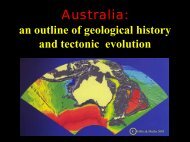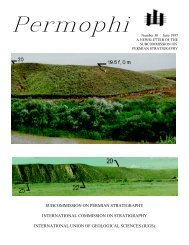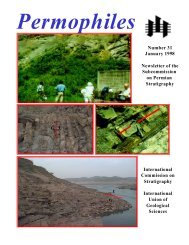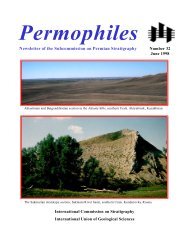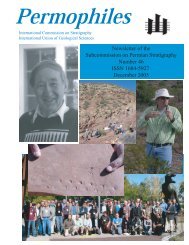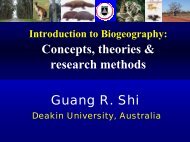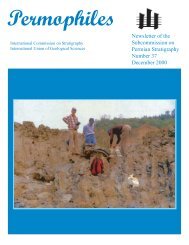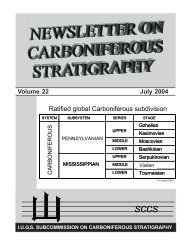Permophiles
Permophiles
Permophiles
Create successful ePaper yourself
Turn your PDF publications into a flip-book with our unique Google optimized e-Paper software.
<strong>Permophiles</strong> Issue #39 2001Morphotype 3 (Fig. 3, D). Small isometric platyspermic (?) seeds5x5 mm with round outlines. Since one of the specimens is broken,some details of inner structure can be studied.The outermost layer consists of two distinctive parts: an outerlayer and an inner layer. They can be interpreted as outer and innerinteguments. At the central part of the seed an ovoid structure ispresent. This structure most probably is a nucellus with megasporemembrane inside.At the seed base the small scarlet occurs. The scarlet correspondsto the place of attachment of the seed to seed-bearingorgan.Palaeobot. Palynol., v. 91, p. 35-62.Andrews, H.N., 1941, Dichophyllum moorei and certain associatedseeds: Ann. Mo. Bot. Gard., v. 28, p. 375-384.The Bursumian StageSpencer G. LucasNew Mexico Museum of Natural History, 1801 Mountain Rd.NW, Albuquerque, NM 87104 USALocality: Aidaralash, layer 17/2, Gzhelian.ConclusionsGenerative organs of pteridosperms belonging toPeltaspermales are described (Peltaspermum sp., Permotheca sp.).Some additional observations on isolated seeds briefly characterizedin open nomenclature are given. Presence of Peltaspermumseed-bearing discs (peltoids) in Gzhelian of the Southern Urals isthe basis to suggest that the most ancient representatives ofpeltaspermalean pteridosperms were as old as Late Carboniferous.The present project supported by Russian Fund for BasicResearch, 00-05-65257.References:Naugolnykh, S.V., 1999, Paleobotany of the Upper Carboniferous/Lower Permian of the Southern Urals. Part 1. Seeds andEnigmatics: <strong>Permophiles</strong>, no 33, p. 27-31.Naugolnykh, S.V., 2000, Paleobotany of the Upper Carboniferous/Lower Permian of the Southern Urals. Part 2. Roots and Woods:<strong>Permophiles</strong>, no 36, p. 24-27.Kerp, H., 1982, Aspects of Permian Palaeobotany and Palynology.II. On the presence of the ovuliferous organ Autuniamilleryensis (Renault) Krasser (Peltaspermaceae) in the LowerPermian of the Nahe area (F.G.R.) and its relationship toCallipteris conferta (Sternberg) Brongniart: Acta Bot. Neerl.,v. 31(516), p. 417-427.Kerp, H., 1988, Aspects of Permian Palaeobotany. X. The WestandCentral European species of the genus Autunia Krasseremend. Kerp (Peltaspermaceae) and the form genusRhachiphyllum Kerp (callipterid foliage): Rev. Palaeobot.Palynol., v. 54, p. 249-360.Krassilov, V.A., Afonin, S.A., Naugolnykh, S.V. 1999, Permothecawith in situ pollen grains from the Lower Permian of the Urals:Palaeobotanist, v. 48, p. 19-25.Aassoumi, H., 1994, Les paleoflores du Permien du Maroc Central:These du Dr. de l’Univ. Paris 6, 227 pp.Bykovskaya, T.A., 1988, Importance of representatives ofCallipteris for stratigraphical correlation (as exemplified byUpper Paleozoic of Tjan-Shan and Europe): Regional geology,mineral resources of the Middle Asia and Kasakhstan, Abstracts,1 st Conf. of young geologists, Dushanbe, p. 5-6.Naugolnykh, S.V., Kerp, H., 1996, Aspects of Permian Palaeobotanyand Palynology. XV. On the oldest known peltasperms withradially symmetrical ovuliferous discs from the Kungurian (uppermostLower Permian) of the Fore-Urals (Russia): Rev.Barry S. KuesDepartment of Earth and Planetary Sciences, University of NewMexico, Albuquerque, NM 87131 USAKarl KrainerInstitute for Geology & Paleontology, University of Innsbruck,Innrain 52, A-6020 Innsbruck, AUSTRIAIn North America, the Carboniferous (Pennsylvanian)-Permian boundary long corresponded to the base of theWolfcampian Stage (Virgilian-Wolfcampian boundary). Therecent establishment in western Kazakstan of a GSSP (globalstratotype section and point) for the Carboniferous-Permianboundary (Davydov et al., 1998) forced the position to changein the North American regional scale. Correlation of this newboundary to the North American fusulinacean zonation indicatesthat the base of the Permian would now be close to the LO(lowest occurrence) of Pseudoschwagerina, which is within theWolfcampian Stage (e.g., Baars et al., 1994b; Wahlman, 1998).Thus, the newly defined Carboniferous-Permian boundarycorresponds to the lower-middle Wolfcampian boundary ofearlier usage (Fig. 1).In the standard global chronostratigraphic scale, eachsystem base corresponds to the base of a stage (e.g., Aubry etal., 1999). Therefore, the secondary standard (sensu Cope, 1996)provided by the North American regional stages should alsohave the Carboniferous (Pennsylvanian)-Permian Systemboundary correspond to the base of a stage, but this requiressome modification or redefinition of the regional stages. Baars etal. (1992, 1994a, b), working in Kansas, proposed to solve thisproblem by redefining the Virgilian Stage to encompass stratapreviously included in the lower Wolfcampian (Fig. 1). A secondsolution, advocated by Ross and Ross (1994), is to recognize anuppermost Carboniferous Bursumian Stage equivalent to thelower Wolfcampian of earlier usage (Fig. 1).Various workers have used the term Bursumian, but onlyRoss and Ross (1994) have presented a rationale for aBursumian Stage between the Virgilian and Wolfcampian.Nevertheless, Ross and Ross provided no explicit definition ofthe Bursumian, but instead based it on Thompson’s (1954) useof the term Bursum Formation in New Mexico and West Texas,USA (Fig. 2). Thus, Ross and Ross (1994, p. 3) stated thatThompson “clearly recognized that this unit [Bursum Formation]had lithologic continuity from north to south in both theSan Andres and Sacramento Mountains of south-central NewMexico and that it extended into the northern part of the Hueco23



